Throughout the 1950s, the Soviet Army helped China to build up their heavy industries. As part of this plan, China established the First Automobile Works (FAW) in Changchun. Soon after, in July 1956 they introduced the Jiefang CA-10 4×2 army truck, a copy of the ZIS-150. Ansd thus, the CA 10 Jiefang became the People's Republic of China's first new truck completed on July 13, 1956. After one million built until 1982, the vehicle was at last sidelined, although a few still in use in civilian service by the 2000s (and still are) in removed regions of China. The vehicle was also used by the North Vietnamese during the war.
About Jiefang and the birth of Chinese trucks
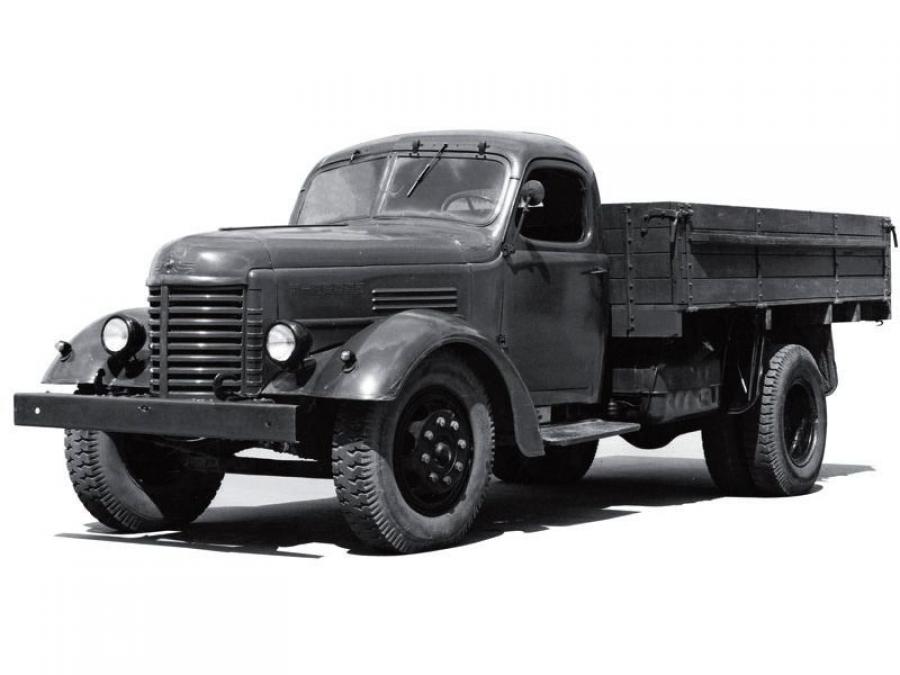 First vehicle as dellivered in 1956
First vehicle as dellivered in 1956
The founding of the People's Republic of China in 1949 was accompanied by help from the USSR, in the shape at first of armoured vehicles, tanks, like the T-54A built in a specially built local factory complex. However the Army also needed to be motorized as shown by the war in Korea, and thousands of Russian trucks were sent to China, mostly WW2 models, produced in USSR and/or ex-US trucks arrived previously via lend-lease. The Sino-Soviet Treaty of Friendship, Alliance, and Mutual Assistance was instrumental in the development of a local industry. Instructors came with vehicles and tooling to helped setup a first production line in 1956, in the North of China for the
Type 59. The "inner Mongolia Factory 617 ("Baotou Tank Plant") was indeed at the root of all subsequent Chinese tank designed until the 1980s and on parallel was established the First Automotive Works in Changchun, Jilin province on July 13. This one was tailored to buil the Soviet ZIL-150 and it's 6-axle variant, both soon known as the Jiefang CA-10 and CA-30.
The simpler CA10 was not even the firs truck, but the first automobile ever made after the founding of the People's Republic of China. Years after, the First Automotive Works predecessor was integrated into the larger, consolidated FAW Group Co., Ltd. always based in Changchun. The very first CA-10 rolled of the line in July 13, 1956, which was a remarkable achievement, helped however by the fact the first were basically assembled trucks from knocked-out kits. But they proudly bore the name of the company on their hood.
The CA-10 became by all accounts a significant milestone in China's automotive and engineering industries. But it was basically a WW2 design. Indeed, the ZIS-150 on which it was based on, was in fact based on the locally produced Studebaker-US6 made at Moscow's Stalin Automotive Factory from 1944. In all, of the 220,000 US5 built in the US, 152,000 were delivered to the Soviet Union. The Red Army appreciated its off-road caracteristocs, modern mechanical aspects compared to the ZIS-5/6, and soon purchased a production licence. The bulk of the production would be deliovered postwar though, and soon derived trucks were designed.
The Soviet ZIL-150 was a 4-axles 2x4 chassis derivative, powered by the same 90-horsepower six cylinder gasoline engine, and despite being shorter, still capable of carrying 4 tons of payload, while being able to reach 65 kilometers per hour. The Chinese soon adopted the ZIL-150 as suggested by Soviet advisors for mass production due to its ruggedness and simplicity. Being manufacturing for more than 30 years Jiefang became "the father of domestically-made autos".

As the first truck in China, the CA-10 is almost the object of a cult, with several on dedicated monuments, like this one.
src
Design of the CA-10
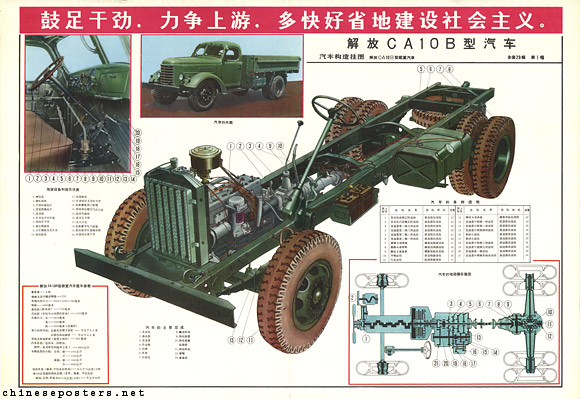 Base chassis with engine
Base chassis with engine
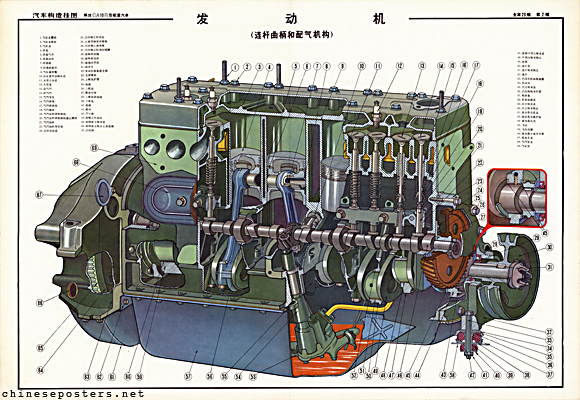 90hp Engine block
90hp Engine block
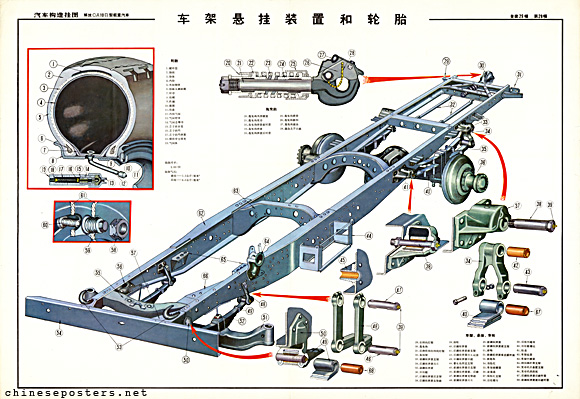 Chassis detailed and tyres (see src below)
Chassis detailed and tyres (see src below)
The CA-10 was defined as a 4×2 truck, weighting 3,540 kg and entering production at the First Automobile Works at Changchun in July 1956. It is based on the Russian ZIL-150, same drive but slightly lighter at 3,500 kg. Although it both the original and copy had limited cross-country capabilities and were primarily produced for commercial use (to put Chinese farmers on the road as announced), it was used as cargo carrier and prime mover for light artillery in Chinese Liberation Army.

The layout of the vehicle is entirely conventional, with the engine at the front, two-door fully enclosed cab in the centre and the cargo area at the rear with drop sides and a drop tailgate. Both left- and right-hand drive models were produced, and variants are known to have included a tractor truck, firefighting vehicles, tankers, crane carriers and dump trucks. Various wheelbase lengths have been produced. The QH-140 truck, produced at the Qinghai plant, was a special variant for use at high altitudes. It was produced in petrol- and diesel-engined forms. The initial CA-10 was followed by the CA-10B in 1960.
The CA-10BX, with a higher compression ratio, maximum speed and power output, appeared in September 1980. It also had changes to the camshaft, carburettor, fuel pump, oil sump, radiator, clutch, starter motor and electrical system, all of which went some way to overcoming earlier technical drawbacks. The CA-10C appeared in January 1982 and is rated at 4,500 kg. The CA-10CJ is fitted with a 100 hp engine and the CA-10CT with a 110 hp engine. The CA-15 has a 5.55-litre 115 hp engine.
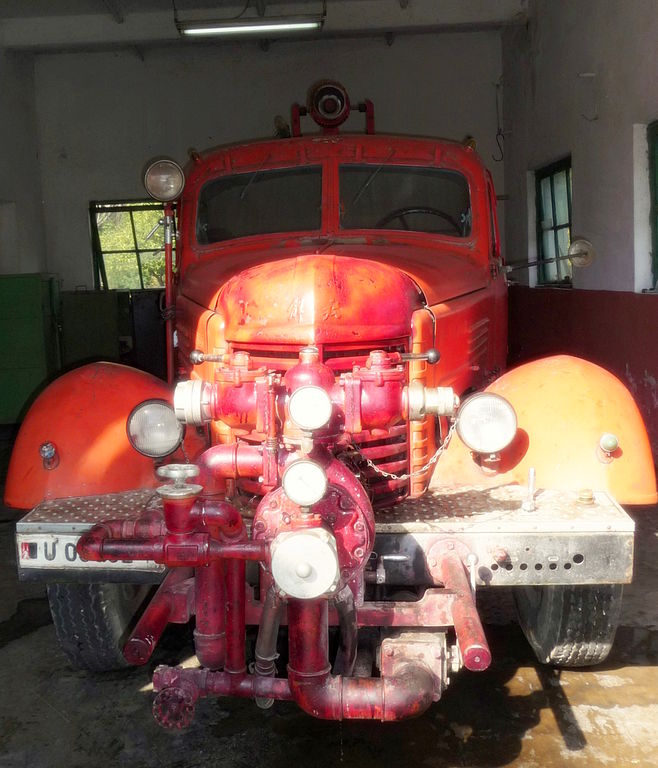 Firetruck variant
Firetruck variant
About variants: Outside the basic carrier/supply truck with a flatbed and optional canvas cover on framing, many versions seems to have been developed based on similar ZIS-150 variants. An avgas tank truck for aviation was developed, as well as a firetruck, with a larger 4-seat cabin. However neither info or photos are available to track more. Being a relatively short flatbed vehicle, as a platform the CA-10 offered just less options than the 6-axles CA-30.
The CA-10 in service
Compared with the original, the CA-10 has a less efficient engine and lacked torque to be a good climber. However despite of this a total production of over one million of all types made it the go-to general purpose truck in China when the production stop as late as 1983. The ZIL-150 had been replaced in USSR since decades by then.
Due to such staggering numbers, not only the vehicle became a staple of the PLAN (not for frontline units which benefited from true off-road capable trucks) but more internal garrison work. They were used in their basic form as supply, cargo and troop transport trucks. They were promiment in footage during the 1969 cultural revolution. But the vehicle was also avilable in numbers to be provided to the North Vietnamese and Viet-Cong forces. Hundreds were used, notably on the infamous "Ho Chi Min Trail". However their poor off-road capabilities had them sidelined to service on good roads inside North Vietnam instead.
By the mid-1980s the First Automobile Works commenced production of the CA-141, later renamed CA-1091 to replace booth the CA-10 and the 6x6 CA-30. By late-2003, still small numbers of CA-10 remained in service with the PLA, mostly specialized vehicles of the Chinese air force and communications units.
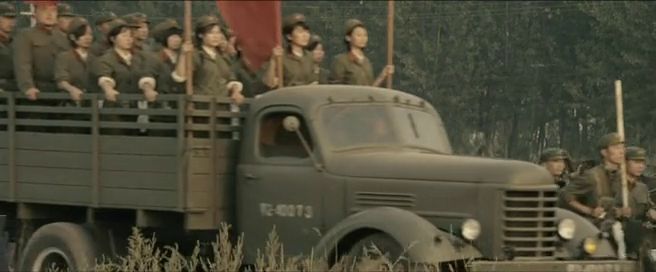
 In movies (both) (imdb), see src
In movies (both) (imdb), see src
⚙ specifications |
| Year of introduction | 1956 |
| Main specs | 3,540 total weight |
| Propulsion & perf. | 90-hp 6-cyl. gas. 65 kph |
| Payload | 4 tons |
| Production | One million in 1982 (circa) |
Read More/Src
https://carnewschina.com/
carnewschina.com/2021/11/28/the-big-read-faw-part-2
flickr.com
automuseum.bjft.gov.cn/automuseum
chinacarforums.com
en.people.cn/
daydaynews.cc/
imcdb.org/
auto.vercity.ru/
chinesecars.net
carnewschina.com
chineseposters.net
wiki ZIS-150
tractors.fandom.com
chinacarhistory.com
Model kit